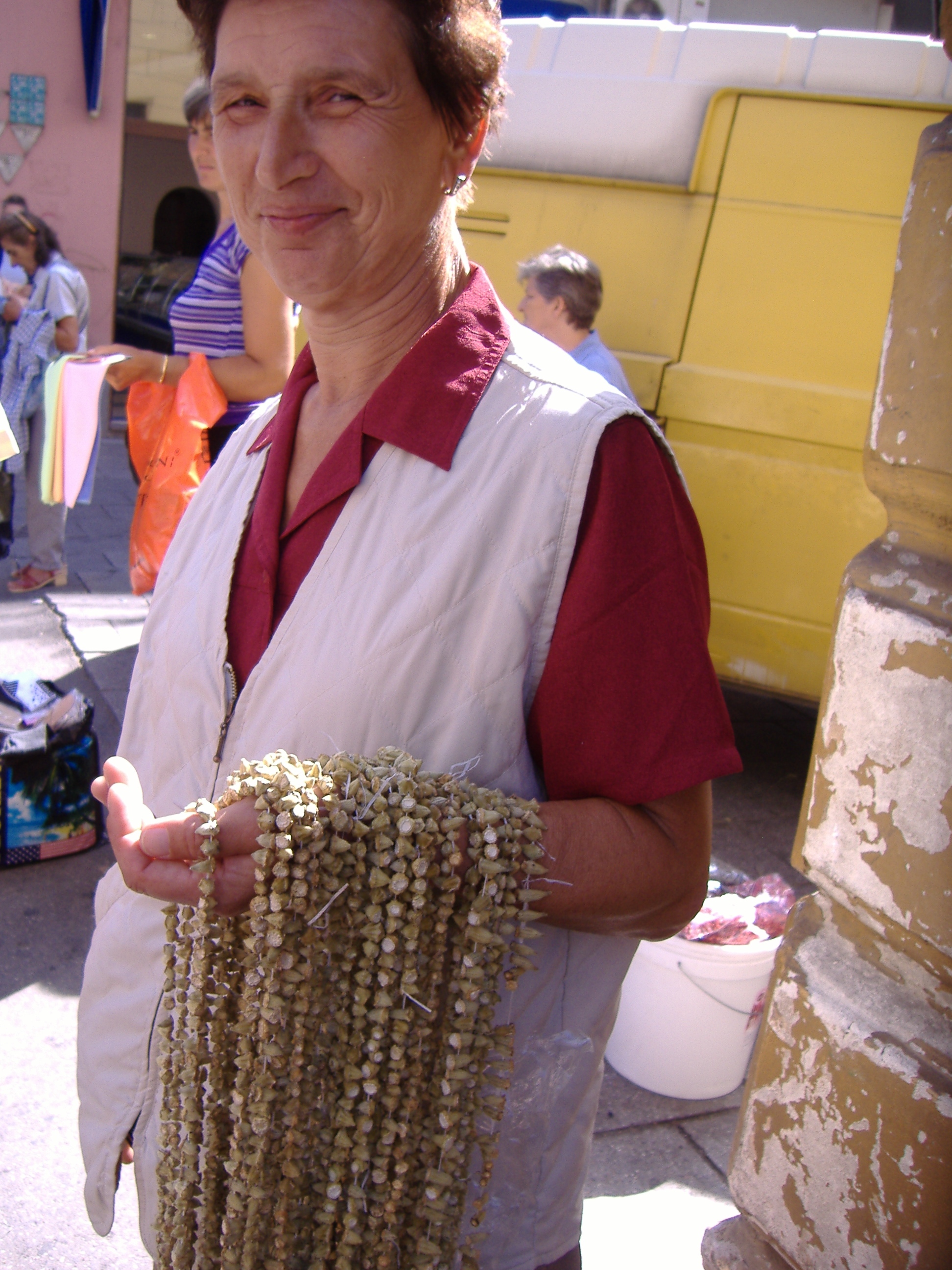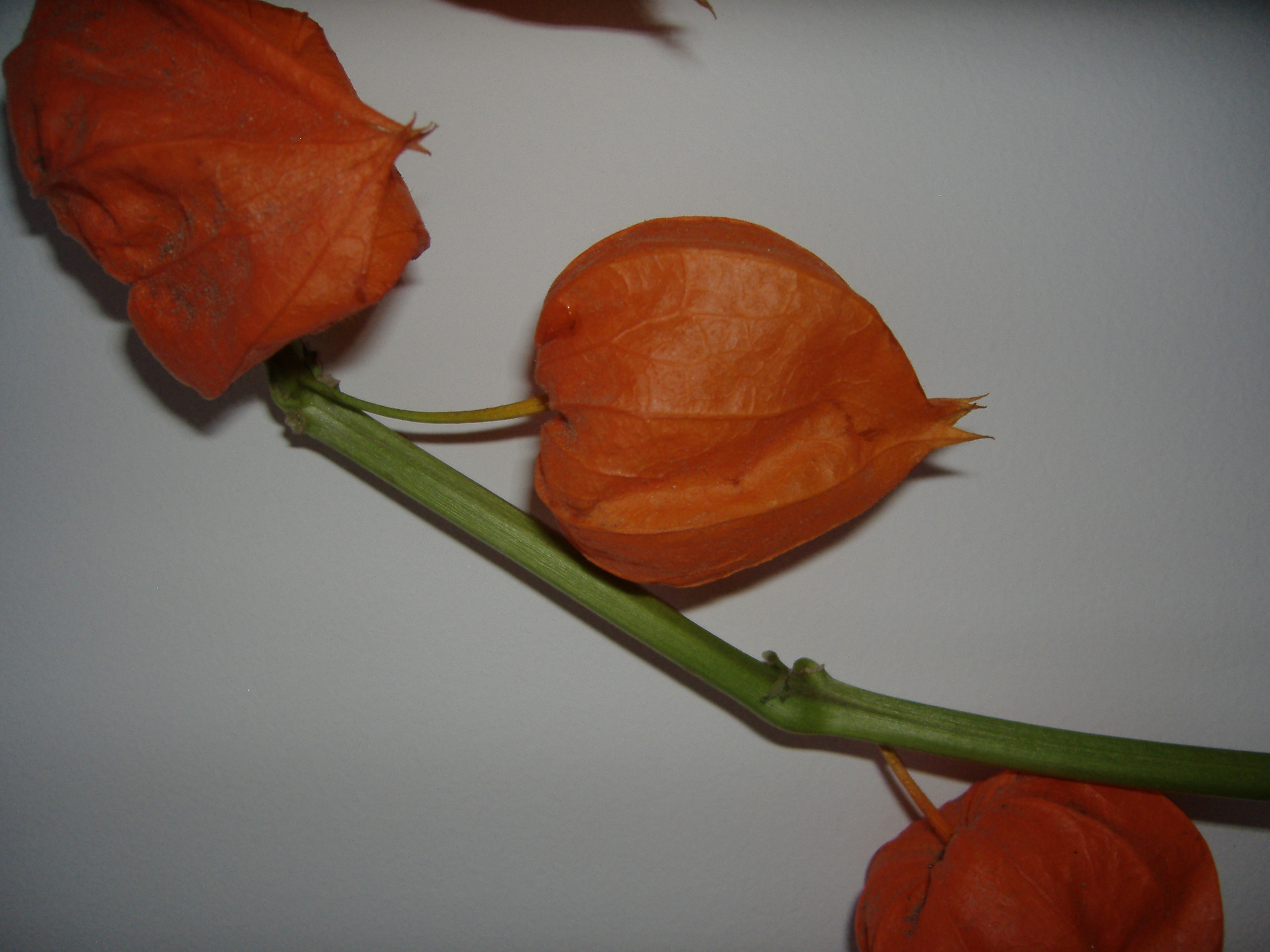I spent an interesting hour or so with Elcio exploring an open-air fruit and vegetable market in central Sarajevo last week. I think it is the very same market which was tragically attacked during the war with much loss of life. No sign of that now, thankfully, except for a memorial to the victims.
You can see some pictures of the fruit and vegetable diversity on display on my Flickr page. Here I just want to point out two curiosities. Or at least they were to me. Here’s the first.
This lady is selling necklaces of dried, perhaps immature but certainly small, okra fruits, called bamia in Bosnian (and indeed in Arabic for that matter). They are soaked in water and vinegar for a few minutes, then added to fried onions and meat to make a local stew. Or that’s what a lady buying some told us. I bought some and will try it. I’d never heard of okra being used in this dried form.
The second thing that came as a surprise to me was this fruit. Sorry I don’t have a decent picture of it being sold in the market.
Clearly some kind of Physalis, perhaps P. alkekengi? It was being sold a few fruits at a time, so probably for medicinal purposes (LATER: or as ornaments?) rather than food. I couldn’t communicate with the lady selling it, the only one in the market. Any ideas?


I agree that the fruit looks like P. alkegengi, but I’d always believed that its fruits were inedible. Could your specimen rather have been P. peruviana, aka Cape gooseberry? I seem to remember that P. peruviana calyx is not as bright orange, more yellow-beige.
Exactly, I think this was way too bright orange for P. peruviana.
I agree that the Physalis pictured could not be Ph. peruviana, which besides having a yellowish calyx, usually has a fruit that more-or-less fills the calyx. This one appears to have a smaller fruit inside an inflated calyx, consistent with the “Chinese lantern” (Ph. alkekengi).
The fruit was indeed small. It was also bright yellow and very bitter. No decent pictures, unfortunately.
Indee Ph. peruviana is a much more pale yellow or light orange. This one in the picture is too dark to be Ph. peruvana.
It is, indeed, used as medicinal as well (Antimicrobial and phototoxic activities). In the Azores (Portugal) I remember, as a young kid, my mother sometimes using Physalis in the fruit salad. The fruit chopped in little pieces and a whole fruit, with the calyx opened up like a flower, sitting on top of the salad in the bowl, as a decorating element.
When I was growing up, okra was one of the key ingredients in my grandmother’s “vegetable” soup, which otherwise included whatever she happened to have (including chicken). It thickens and adds body and taste. We grew it on the family farm in Tennessee, in the southern U.S. (an introduction to the New World and my region linked to slavery perhaps). But, we had to dry it to have it in the winter. We sliced it before drying and even thinly sliced the pieces were bigger than the ones shown in the photo. When dry, okra weighs next to nothing, and a little goes a long way. The photo is fascinating. Whole okra? Wow. Nice for a necklace, but if you are drying it to eat later, would you harvest it small? (why?) Or is it a very VERY small variety? Interesting. Wonder if it had the small hairs that used to be common before breeders got rid of these botanical glass shards.
This prompted me to recollect tracking down some genuine filé powder ages ago when I was attempting to make genuine gumbo in the swamps of Somerset. Filé is made from the powdered leaves of the Sassafras tree (Sassafras albidum) and is also used to thicken soups and stews. According to Wikipedia, it was originally used as a substitute for okra, when okra was not in season — but Wikipedia needs a citation to back that up, if anyone has one.
Which prompts my customary question; what first prompted some unknown genius to dry and powder the roots of a tree as a substitute for the fruits of a bush?
The very interesting orange Physalis, which I had necver seen before, it seems to be the Physalis alkekengi (Bladder cherry, Chinese lantern, Japanese lantern, or Winter cherry; Japanese: hÅzuki), which is a relative of P. peruviana. Commonly called chinese lanterns, due to its bright orange to red cover like in the picture resembling the Chinese lanterns. And it this is native from southern Europe east across southern Asia to Japan.
Regarding Jeremy’s question about whatever possessed someone to try substituting powered sassafras roots for okra, who knows? I’ve often marveled at the number of “experiments” that must have been undertaken to separate edible from non-edible plants, and identify the various uses. And…how many experimenters got sick or worse in the process.
One additional memory to share; when I was a kid, a couple of times a year a man would walk through the neighborhood yelling out that he had sassafras, and would sell small bundles of the roots, for making tea. It was a treat – we always bought some. But, later I think I recall a finding that there was some medical danger associated with drinking the tea, and as far as I know the practice largely died out for this reason, and probably as a result of larger cultural reasons. Maybe I’m wrong about the health link, because as Jeremy notes, it’s still sold in powered form. The Oxford Companion to Food doesn’t say anything about negative health aspects, but it does says that long ago people boiled the sap of sugar maples in the spring when it was most abundant and then threw in sassafras roots for flavoring – “a drink fit for the gods was the result.” It also quotes Euell Gibbons (remember him?) as saying that sassafras was used as a lure to bring Europeans across the Atlantic in search of their fortunes, but that the tree was too common to attain high value. Hmmm. Do we think the Europeans were really lured by sassafras, or were they just searching for a good bowl of gumbo in the off-season?
Sassafras tea (and the original recipe for “root” beer) is made from the steeped roots of the tree. Filé is made from the powdered leaves of the same plant.
It contains (both products) safrole, the major flavor component can cause nerve damage, liver tumors and other nice stuff with longterm exposure. Thus it was banned as an ingredient in food additives by the FDA a couple of decades ago. Because of it’s “natural” status, tea and filé are still available. Try middle eastern stores for the powder.